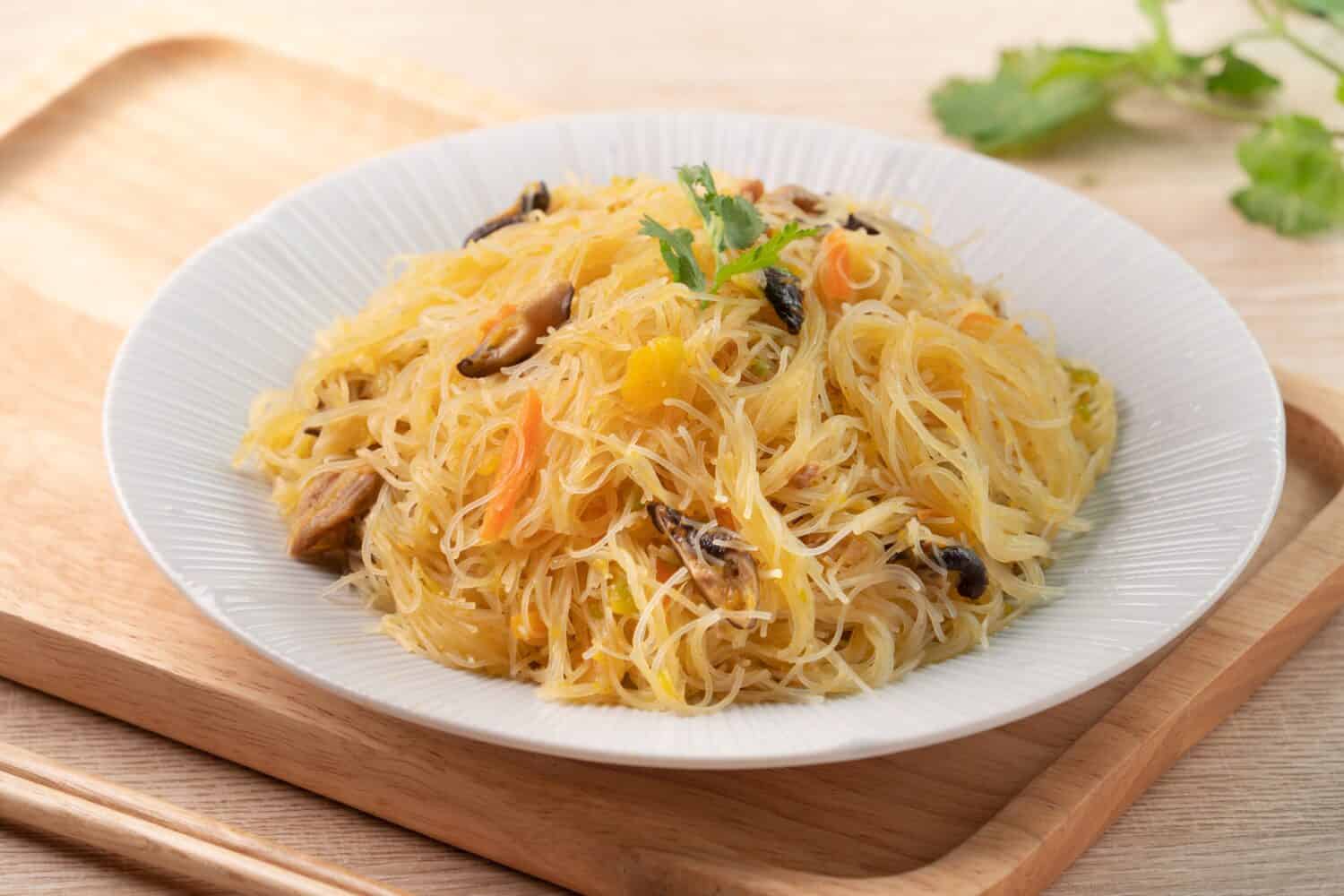When it comes to Asian cuisine, there are numerous types of noodles to choose from. Two of the most common types of noodles for soup, stir-fries, and similar dishes are glass noodles and vermicelli. If you're trying to choose the right type for your recipe, you might wonder what the difference is between vermicelli vs. glass noodles.
Most commonly, vermicelli noodles refer to a type of rice noodle made from rice flour. This is the main difference between vermicelli and glass noodles: vermicelli is a thin type of rice noodle made from rice flour while glass noodles are usually made from mung bean starch.
Keep reading to discover the main differences between vermicelli vs. rice noodles and what you can substitute for each.
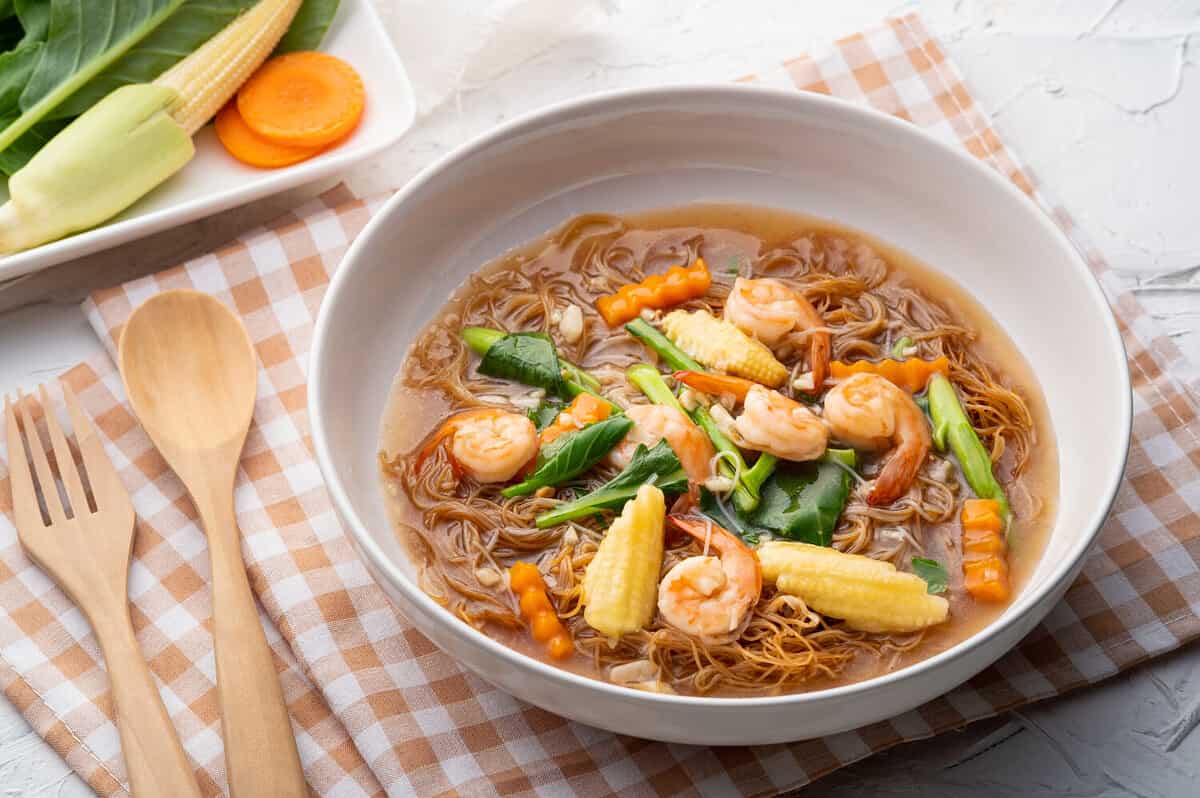
©Kritchai7752/Shutterstock.com
Vermicelli vs. Glass Noodles: What Is the Difference?
No matter what type of dish you’re making, noodles are an excellent base for soups and salads, and they even make a perfect side dish. But when you’re trying to choose the right kind of noodle, it’s important to know the difference between some of the most common types. When it comes to Asian noodles, two of the types you may come across are vermicelli and glass noodles.
Glass noodles get their name from their translucent appearance, and are also called cellophane noodles. These noodles are made from a type of starch. Glass noodles are usually made from mung bean starch, but they can also be made from potato or sweet potato starch.
Although vermicelli can refer to several different types of noodles, rice vermicelli is the most common type in Asian cuisine. Rice vermicelli is a type of noodle made from rice flour and water. There are sometimes other ingredients, such as tapioca starch, added to make them softer, but generally, rice flour and water are the two main ingredients.
What Are Glass Noodles?
Glass noodles, also known as cellophane noodles, are a popular type of noodle common in Asian cuisine. These noodles are often made from mung bean starch, leading to them sometimes being called bean threads. Sometimes they are made from a different type of starch, such as Korean glass noodles that are made from sweet potato starch.
Glass noodles, once dried, are typically translucent but may have a greyish or greenish tint, depending on the type. They usually have a chewy texture and can be soaked prior to cooking which leads to a softer texture.
What Are Vermicelli Noodles?
Vermicelli noodles are a type of rice noodle that is very thin and made from rice flour. When you look up vermicelli noodles, it may be confusing since there are many different types of vermicelli. Vermicelli can actually refer to an Italian type of noodle made from durum wheat, or it can refer to a type of noodle made from maida flour.
When vermicelli noodles are mentioned in Asian cuisine, they’re referring to rice vermicelli noodles. These are a type of rice noodles that are thin, white, and chewy. Rice noodles come in a variety of sizes, with vermicelli being the thinnest type.
Substitutes for Vermicelli
Vermicelli can describe rice vermicelli in Asian cuisine or Italian vermicelli noodles made from wheat. There are many substitutes for both types of noodles. If you’re looking for a substitute, consider one of the following:
Glass Noodles
If you’re looking for a substitute for vermicelli noodles, you can use glass noodles as a substitute. They do have many differences, such as their flavor and texture, but they also can be used interchangeably in many recipes.
Thick Rice Noodles
Rice vermicelli noodles are a thin type of rice noodle, but there are many other varieties of rice noodles. If you’re looking for a substitute for the thin type of rice noodle, you can choose to use thick, flat rice noodles instead. These will give you a similar flavor and texture but a different shape.
Soba Noodles
Soba noodles are a type of Asian noodle made from buckwheat flour. As far as the texture and use in a dish, they are going to work similarly, but they will have a different flavor. Soba noodles are thick and have a nutty flavor that comes from buckwheat flour.
Udon Noodles
Udon noodles will be closer to the flavor of vermicelli since they have a mild flavor, but they’re also a lot thicker than soba or vermicelli noodles. They do have a chewy texture like glass noodles or vermicelli noodles and can work well as a substitute in many dishes.
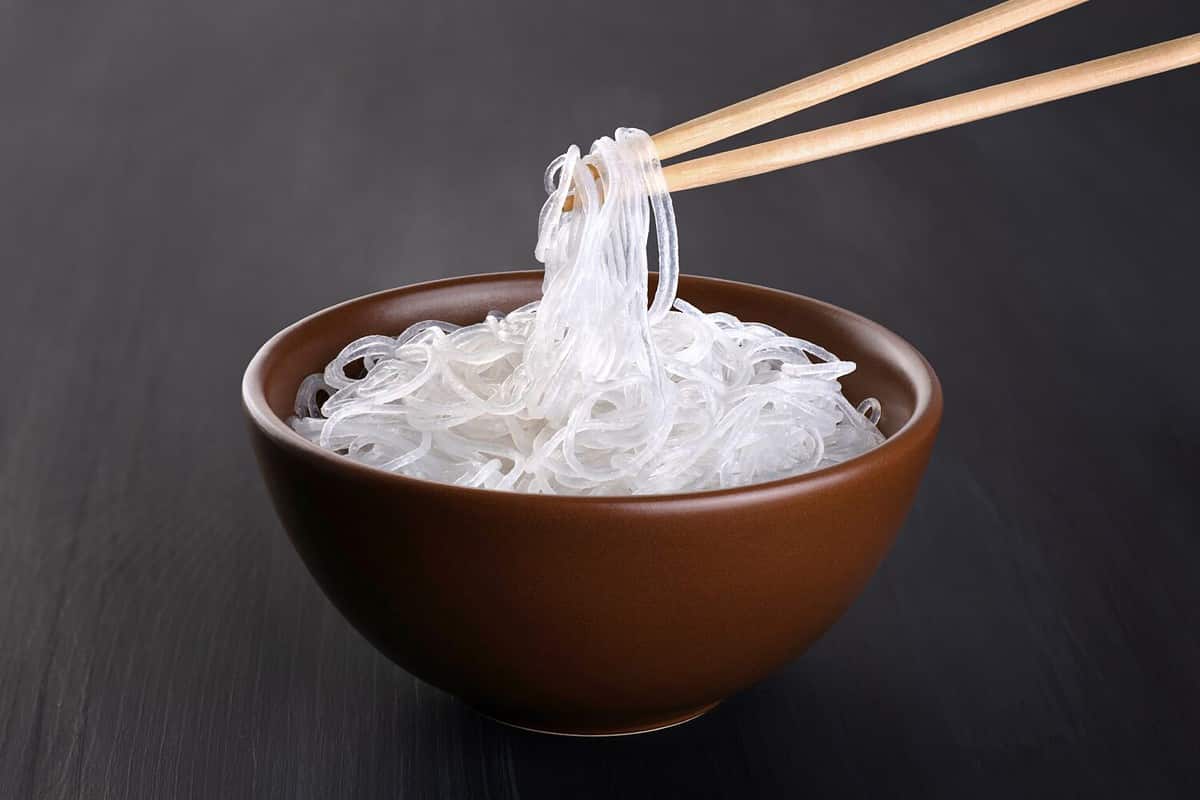
©vitals/Shutterstock.com
Substitutes for Glass Noodles
Glass noodles are usually made from mung bean starch and are relatively flavorless. If you’re looking for a substitute for glass noodles, consider the following:
Vermicelli
If you can’t find glass noodles, vermicelli noodles can be a good substitute since they have a similar shape and width. Although they have a slightly different flavor, this isn’t necessarily a bad thing depending on what dish you’re making. Glass noodles don’t have much flavor but they do soak up the flavor of the dish you’re cooking them in.
Thick Rice Noodles
Compared to vermicelli, the main difference between them and thick rice noodles is their shape. They have a very similar flavor to vermicelli and depending on the recipe you’re making, a thicker noodle may be better at holding sauce. If you can’t find vermicelli or are looking for a thicker substitute, consider using thick, flat rice noodles instead.
Soba Noodles
Soba noodles are a good substitute for glass noodles, especially if you’re using them for a dish like stir-fry. These noodles are made from buckwheat flour, so they have a nuttier flavor, but they work great in dishes such as stir-fry where they’re mixed in with different sauces and flavors.
Angel Hair Pasta
If you’re in a pinch, you can use angel hair pasta as a substitute for glass noodles. Since angel hair is a very thin Italian pasta, it has a similar shape and texture. This type of pasta is made from wheat so it’s not translucent like glass noodles, but it works well as a substitute, especially in soups.
Which Is Healthier: Vermicelli or Glass Noodles?
The nutritional values of vermicelli vs. glass noodles do differ, but not significantly enough to determine whether one is much healthier than the other. Both are relatively low in calories, sodium, and sugar, but have a decent amount of carbs.
There’s not a significant amount of nutrients or vitamins that come from either type of noodle, so the health benefits of your meal are going to mostly come from the rest of the ingredients. You can make both types of noodles as part of a healthy meal by including more vegetables in your soup or stir fry and paying attention to the amount of sodium and sugar in the sauce.
Nutritional Values of Vermicelli vs. Glass Noodles
| Nutritional Values | Vermicelli | Glass Noodles |
| Calories | 190 | 161 |
| Total Fat | 0.4 g | 0 g |
| Cholesterol | 0 mg | 0 mg |
| Sodium | 33 mg | 10 mg |
| Total Carbs | 42 g | 40 g |
| Sugar | 0.1 g | 0 g |
| Protein | 3.2 g | 0.1 g |
| Iron | 0.3 mg | 1 mg |
| Potassium | 7 mg | 4.6 g |
Takeaway
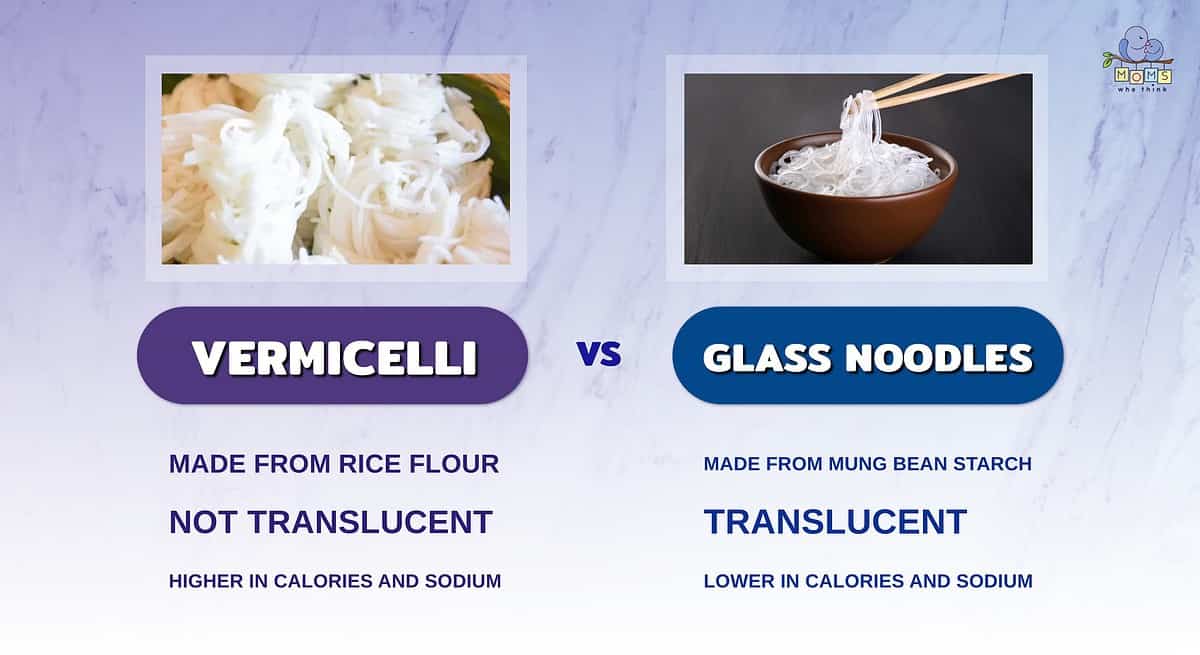
- There are many different types of vermicelli, but in this article we've considered the one that's an Asian staple. This particular type of vermicelli is made with rice flour, contrasting the mung bean starch that's used in glass noodles.
- Vermicelli are not translucent, while glass noodles have a distinct translucency that gives them their name.
- Glass noodles are lower in calories (although not by much) and sodium compared to vermicelli, making them a better choice for those watching their sodium intake.
Noodles are a staple in many Asian dishes from soups to hot pot. There are numerous ways to use each type of noodle and various types of noodles, with two of the most popular being vermicelli and glass noodles.
While vermicelli can refer to a few different types, in Asian dishes, it usually refers to rice vermicelli, which is a thin type of rice noodle. Rice vermicelli noodles are made from rice flour and water and are typically white. Glass noodles, on the other hand, are made from a type of starch such as mung bean starch.
Whether you’re cooking up a stir-fry dish or you’re making an Asian-inspired soup like pho, you can use both types of noodles in various ways. Next time you’re ordering at your favorite Asian restaurant, remember the differences between vermicelli and glass noodles.
Check out this amazing Asian noodle bowl recipe:
Print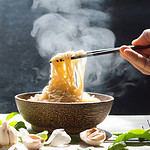
Asian Noodle Bowl
Ingredients
8 ounces of vermicelli noodles
2 cups vegetables broth
1/2 cup bottled peanut sauce
2 cups Chinese-style frozen stir-fry vegetables
1/2 cup dry roasted peanuts, chopped
Instructions
1. Cook noodles according to package directions; drain but do not rinse. Set aside.
2. In the same pan, combine broth and peanut sauce. Bring to a boil.
3. Stir in frozen vegetables and cooked noodles, return to boil, reduce heat.
4. Simmer for 2 to 3 minutes or until vegetables are heated through.
5. Divide noodles and broth among 4 bowls.
6. Sprinkle with peanuts.
The image featured at the top of this post is ©YamisHandmade/Shutterstock.com.
